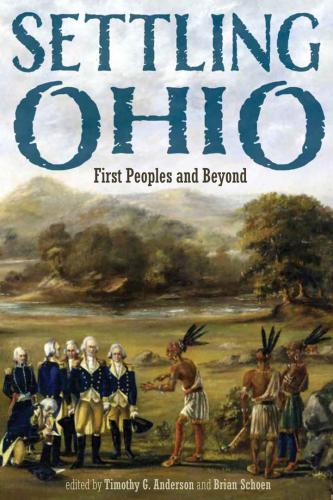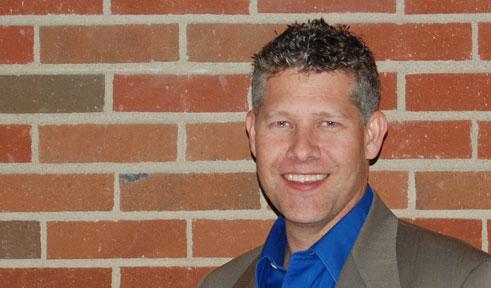
Professors' new book traces Ohio history from first peoples to first settlers

The official founding of the state of Ohio dates back to 1803, but human habitation in Ohio goes back much further, back to the first peoples and first settlers who helped shape the state we know today.
Professors in OHIO’s College of Arts and Sciences, Timothy G. Anderson and Brian Schoen, have worked to present the rich early history of Ohio through a newly edited book titled, “Settling Ohio: First Peoples and Beyond,” published by the Ohio University Press.
The book is a collection of essays with a foreword by President Emeritus and Trustee Professor of Geography Dr. M. Duane Nellis and an afterword by Chief Glenna Wallace of the Eastern Shawnee tribe. It includes chapters by multiple scholars, historians, geographers and more that outline how difficult and contingent early national politics and frontier development in Ohio could be.
“This book provides a more comprehensive view of the multiple dimensions of ‘settlement,” which began not with the first European Americans but perhaps as early as ten thousand years ago toward the end of continental glaciation,” Nellis says in his foreword to the book.
On July 15, both Anderson and Schoen will present “Settling Ohio” at the Columbus Book Festival, discussing the first people who inhabited the Ohio Valley region, how they built civilizations, established trading networks and navigated wars, and sought to preserve their identity and land. Following their presentation, they will also travel to northern Ohio to present at Lakeside and Case Western Reserve University.

“‘Settling Ohio’ depicts the often-forgotten history of multiple non-white populations displaced by the processes of settler colonialism that has often been undervalued in both the teaching and study of the past,” said Anderson, associate professor of geography.
The book begins with an introduction of the first people to inhabit the region, highlighting how, in the 18th century, Native Americans who migrated from the east and north interacted with Europeans to develop impressive trading networks in Ohio.
Many people are familiar with the story of Ohio settlement that focuses on the Northwest Ordinance, the dealings of the Ohio Company of Associates and early transportation networks, however, “Settling Ohio” weaves these historical milestones into a far richer story of contested spaces, competing visions of nationhood and complicated relations with Indigenous peoples.
“The book was created to be almost an addition to David McCullough’s popular book ‘The Pioneers,’ which provided a look at early settlement in Ohio,” said Schoen, associate professor and History Department chair and the James Richard Hamilton/Baker and Hostetler Professor of the Charles J. Ping Institute for Teaching of the Humanities. “We wanted to ensure that we were providing a more complete picture of who first settled Ohio and depict the multiple other populations who shaped the state and region’s political, social and cultural landscapes.”
According to Schoen, when McCullough’s book was released, there was a lot of discussion around the topic, and he and Anderson thought it could be helpful to host an event at OHIO that broadened the scope of the book. With help from the Central Regional Humanities Center and the Southeastern Ohio History Center, Schoen and Anderson held the Ohio Settlement Conference in February of 2020 where close to 300 people including OHIO students, staff, faculty, alumni and community members came out to learn more.

“The energy we saw from the speakers and the broader public when discussing these topics was exciting,” Schoen said. “People were really interested in this topic, and it was then that we thought, ‘what if these speakers could write down this information to make it accessible to everyone?’ That’s what ended up leading to the book.”
Nearly every conference speaker ended up writing chapters for the book.
Ohio University’s Joseph Gingerich, associate professor of anthropology, kicked off the conference and also wrote the first chapter of the book, “The True Pioneers: a Brief Overview of Prehistoric Native Americans in Ohio.”
In addition to Anderson, Schoen, Gingerich and Chief Wallace, the book’s authors include John Bickers, assistant professor of history at Case Western Reserve University and a citizen of the Miami Tribe of Oklahoma; Anna-Lisa Cox, non-resident fellow at Harvard University’s Hutchins Center for African and African American Research; Kim Gruenwald, associate professor of history at Kent State University; William Hunter, a historian and geographer for the National Park Service; William Kerrigan, professor of history at Muskingum University; Adam Nelson, senior associate dean in the School of Education and Vilas Distinguished Achievement Professor of Educational Policy Studies and History at the University of Wisconsin-Madison; Jessica Choppin Roney, associate professor of history at Temple University; Joseph Ross, an independent scholar and Ohio University graduate of the History graduate program; and Cameron Shriver, research associate at the Myaamia Center and visiting assistant professor of history at Miami University.
“There are many themes that emerge within the book, but another part that people find fascinating is the family connections that brought people to Ohio and the genealogical geology of a place,” Anderson explained. “Both Indigenous and European groups, as well as Anglo Americans and African Americans all settled into different regions. Due to the movement of people, certain regions’ make up both culturally and politically varied quite a bit.”
The chapters in the book range on various topics like the role of apple-growing culture and Johnny Appleseed, education, African American settlers and the diverse migration flows into Ohio from the East and Europe further demonstrate the complex, multiethnic composition of Ohio’s early settlements and the tensions that resulted. Other pieces reexamine the context for well-known documents and political dynamics, including bold new ways of thinking about the Northwest Ordinance and the often chaotic white settlement of the Ohio Territory.
“For me, Chief Wallace’s part of the book is what resonates the most,” Anderson said. “Her chapter feels like a stream of consciousness from the heart about the ideas of memory and how oral history goes back generations. I knew Native Americans created all sorts of landscapes in Ohio, but there is something about how she presents the impact and voices of those who have been marginalized to the forefront in this narrative. She tells her life story and really weaves the history of the Shawnee people in Ohio in this book.”
“As historians, there’s a fear that sometimes history can be presented in a one-dimensional way. You can either tell the side of triumph or defeat, the history of one group of people over another, but history is not a zero-sum game. What we aim to do is provide readers with a more complete three-dimensional view of the diverse players involved and the complicated history that unfolded in early Ohio,” Schoen said.
Watch Chief Glenna Wallace and other speakers from the Ohio Settlement Conference.
See more information at “Ohio’s First Humanists: Native Americans from Mound Building to Modern Voices,” a collaboration between Ohio University’s Charles J. Ping Institute for the Teaching of the Humanities, the Athens Department of Arts, Parks and Recreation, and the Athens County Public Libraries.
